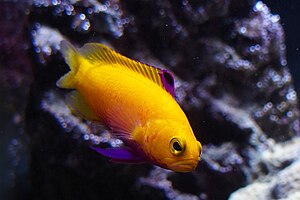Dejong's fairy bass
| Dejong's fairy bass | ||||||||||||
|---|---|---|---|---|---|---|---|---|---|---|---|---|

Dejong's fairy bass ( Gramma dejongi ) |
||||||||||||
| Systematics | ||||||||||||
|
||||||||||||
| Scientific name | ||||||||||||
| Gramma dejongi | ||||||||||||
| Victor & Randall , 2010 | ||||||||||||
Dejong's fairy bass ( Gramma dejongi ) is a small marine fish that occurs in the Caribbean and has so far only been found on the coast of Cuba . The species was only described in 2010 and named after the Dutch ornamental fish importer Arie de Jong, who noticed the species differing in color in a consignment of king fairy bass ( Gramma loreto ). The type specimens that De Jong made available came from the south coast of Cuba and were caught near Trinidad .
features
With a maximum length of 4.5 cm, Dejong's fairy bass remains almost half the size of the king fairy bass, which becomes 8 cm long. Above all, Dejong's fairy bass differs from the two-tone king fairy bass, which is magenta on the front and yellow on the back, due to its golden-yellow basic coloration that encompasses almost its entire body. Only the front three or four dorsal fin rays , the pelvic fins , the base of the pelvic fin and the throat region are magenta in color . The second ray of the pelvic fin is blackish. A black spot, the diameter of the pupil, lies on the upper part of the three or four anterior dorsal fin rays. The dark eye-line characteristic of the king fairy bass is missing.
- Fin formula : dorsal fin XII / 10, anal fin III / 10, pectorals 15-16.
habitat
Dejong's fairy bass occurs on the coasts of Cuba sympathetically with the king fairy bass and the black- capped fairy bass ( Gramma melacara ). While the former prefers shallow water and the latter lives at greater depths (up to 180 meters), the type specimens of Dejong's fairy bass were only caught at depths of 20 to 30 m. There he lives hidden in outer reefs .
literature
- Victor; Randall (2010). Gramma dejongi, a New Basslet (Perciformes: Grammatidae) from Cuba, a Sympatric Sibling Species of G. loreto. Zoological Studies 49 (6): 865-871. PDF
Web links
- Gramma dejongi on Fishbase.org (English)